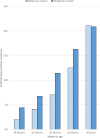Risk of Adverse Obstetric and Neonatal Outcomes by Maternal Age: Quantifying Individual and Population Level Risk Using Routine UK Maternity Data
- PMID: 27716789
- PMCID: PMC5055305
- DOI: 10.1371/journal.pone.0164462
Risk of Adverse Obstetric and Neonatal Outcomes by Maternal Age: Quantifying Individual and Population Level Risk Using Routine UK Maternity Data
Abstract
Objective: The objective of this study was to investigate whether moderately increased maternal age is associated with obstetric and neonatal outcome in a contemporary population, and to consider the possible role of co-morbidities in explaining any increased risk.
Study design: Secondary analysis of routinely collected data from a large maternity unit in London, UK. Data were available on 51,225 singleton deliveries (≥22 weeks) occurring to women aged ≥20 between 2004 and 2012. Modified Poisson regression was used to estimate risk ratios for the association between maternal age and obstetric and neonatal outcome (delivery type, postpartum haemorrhage, stillbirth, low birthweight, preterm birth, small for gestational age, neonatal unit admission), using the reference group 20-24 years. Population attributable fractions were calculated to quantify the population impact.
Results: We found an association between increasing maternal age and major postpartum haemorrhage (≥1000ml blood loss) (RR 1.36 95% CI 1.18-1.57 for age 25-29 rising to 2.41 95% CI 2.02-2.88 for age ≥40). Similar trends were observed for caesarean delivery, most notably for elective caesareans (RR 1.64 95% CI 1.36-1.96 for age 25-29 rising to 4.94 95% CI 4.09-5.96 for age ≥40). There was evidence that parity modified this association, with a higher prevalence of elective caesarean delivery in older nulliparous women. Women aged ≥35 were at increased risk of low birthweight and preterm birth. We found no evidence that the risk of stillbirth, small for gestational age, or neonatal unit admission differed by maternal age.
Conclusions: Our results suggest a gradual increase in the risk of caesarean delivery and postpartum haemorrhage from age 25, persisting after taking into account maternal BMI, hypertension and diabetes. The risk of low birthweight and preterm birth was elevated in women over 35. Further research is needed to understand the reasons behind the high prevalence of elective caesarean delivery in nulliparous older mothers.
Conflict of interest statement
The authors have declared that no competing interests exist.
Figures
References
-
- Office for National Statistics. Birth Summary Tables, England and Wales 2013,. ONS, 2014.
-
- European Commission. Eurostat: Fertility statistics (Data from May 2014) 2014 [cited 2014 November]. Available from: http://epp.eurostat.ec.europa.eu/statistics_explained/index.php/Fertilit....
-
- Australian Bureau of Statistics. Births, Australia 2013 (3301.0) 2014 [cited 2014 November]. Available from: http://www.abs.gov.au/ausstats/abs@.nsf/Latestproducts/3301.0Main%20Feat....
-
- Waters E, Wager H. Pregnancy and labor experiences of elderly primigravidas. J Mich State Med Soc. 1950. 49(4):435–9. - PubMed
MeSH terms
LinkOut - more resources
Full Text Sources
Other Literature Sources
Medical


